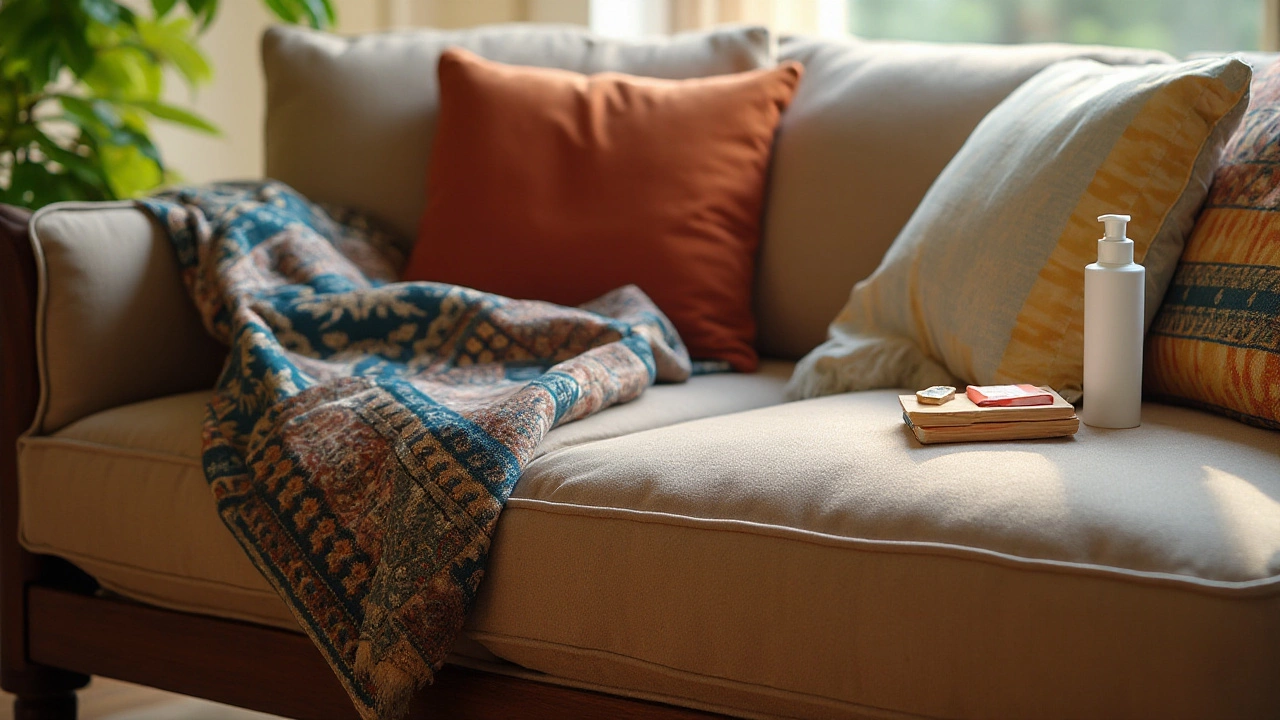Lazy Boy couches have carved a niche in many homes, blending style with comfort. You may often wonder, how long does one of these sofas last before you need to think about replacing it? It's not just about wear and tear; a variety of factors play a role in determining a couch's lifespan.
From the materials that shape its form to how you incorporate it into daily life, there are several aspects to consider if you want your investment to go the distance. Let's embark on a detailed journey through the intricacies that contribute to the time a Lazy Boy can faithfully serve your household.
- Understanding Couch Durability
- Factors Affecting Longevity
- Maintenance and Care Tips
- Signs It’s Time to Replace
Understanding Couch Durability
When it comes to the lifespan of a Lazy Boy couch, durability is the cornerstone of any conversation you might have about quality furniture. A variety of elements can influence a sofa's endurance, from the craftsmanship involved to the materials employed. Let's break it down piece by piece, starting with the frame. The frame acts as the skeleton, providing structure and support. High-quality frames are often made from hardwoods such as oak, ash, or birch, known for their strength and longevity. These materials resist wear and tear better than softer woods or engineered wood options. If you've ever been curious, this is where a couch's true strength begins.
The next critical aspect involves the upholstery materials. The outer layer not only adds to the aesthetic appeal but also shields the inner components of the couch. Fabrics like microfiber, genuine leather, and certain polyester blends are revered for their resistance to stains and abrasions. The ease of cleaning plays a massive role too. Furniture experts often emphasize checking the durability ratings of these fabrics before making a purchase. For instance, the rub count (a test of fabric resilience) provides insight into how well the material will stand up to daily use over many years. This insight is crucial, as lesser fabrics may show signs of distress within a short timeframe.
Let’s not overlook the role of the internal cushioning and its impact on sofa durability. High-density foam is generally seen as the gold standard for providing consistent support and retaining shape. Over the years, it has undergone many improvements, with newer forms engineered to avoid the inevitable sagging you see in lower-quality foams. One might say the heart of comfort lies within these cushions, ensuring your Lazy Boy remains a haven of relaxation even after countless family movie nights or gatherings.
"A good couch is like a pair of sturdy boots," says renowned furniture designer Deborah Silverstein. "Investing in the right materials and care will carry you far beyond the initial purchase."
We should not skip the details related to couch joints, where the separate pieces connect. A well-constructed piece will feature double-doweled and corner-blocked joints, secured with durable screws instead of glue alone. This factor significantly enhances couch lifespan by reducing the chance of unexpected structural failures. Many hidden nuances are embedded within these fine details.
Additional Factors in Durability
Another essential topic in understanding couch durability might include the role of environmental factors. Things like humidity, light exposure, and even room placement can accelerate aging. Careful consideration and prevention steps could notably increase your couch's lifespan. If you place your Lazy Boy away from direct sunlight and maintain a steady humidity level, you'll be preserving its color and structural integrity. These small adjustments can collectively add years to the usage of your sofa, making it not just a lazy purchase, but also a wise one.
In some cases, homeowners choose to add protective covers or apply fabric treatments to fend off everyday spills. These additions might seem minimal, but they can dramatically extend how long your couch keeps its fresh, new-couch look. Each element, from frame to fabric, intertwines to offer insights into why some Lazy Boy couches stand the test of time better than others. Whether it’s sitting around for long conversations or entertainments, a well-maintained couch can be the center of your living space for many years to come.

Factors Affecting Longevity
Diving into the realm of sofas, particularly those from Lazy Boy, one quickly realizes that the duration of their serviceable life encompasses more than just material robustness. The key to understanding how long your couch lifespan may stretch lies in peeling back the layers of what influences such an integral piece of home furnishing. First off, let’s consider the materials used. Lazy Boy couches often boast a range of materials from robust leather to versatile fabric. Leather couches can last significantly longer due to their resilience and ease of cleaning. Fabric will often wear differently depending on the weave and durability, with denser weaves lasting longer. These choices not only affect aesthetics but durability, given that any spill or wear is a test to the material's lasting power.
The manner in which a couch is constructed also plays a pivotal role. A solid frame, commonly made from kiln-dried hardwood, can withstand years of pressure and movement without deteriorating. Joinery techniques, such as dowels and corner blocks, enhance stability and longevity. In simpler terms, the skeleton of a couch dictates its aging process. Add to this the type of cushions—high-density foam retains its shape longer than fiberfill, offering comfort over a decade of use. All these factors together shape a couch's inherent durability.
Usage Patterns
Another layer that profoundly affects the sofa durability is the use habits of its owners. A family of four with kids may find their couch showing signs of age faster than a single household. It’s not only about the number of people but the frequency and manner of use. Daily lounging, jumping children, or even mischievous pets can accelerate wear. Each of these activities increases the friction and stress on the couch’s material and structure, meaning it needs to be built for such life. Regular rotation of cushions and consistent cleaning can mitigate some of these effects, prolonging the enjoyment of your furniture.
Environmental Factors
Environment, though often overlooked, is another contributor that affects how long a Lazy Boy can last. Furniture placed in direct sunlight, subjected to changes in humidity or temperature, can encounter premature aging. Sun exposure may cause fabrics to fade and leather to crack, while humidity can warp wooden components. By placing the couch away from direct heat sources and using treatments or curtains to protect against sunlight, these environmental impacts can be significantly reduced, contributing to a longer life of the sofa.
"A well-ventilated room minimizes the build-up of moisture, prolonging the life of your wooden furniture," notes Emily Herriot, a renowned interior designer.
The conscience of the caretaker, in terms of maintenance and preventive care, is another fundamental component. Regular dusting and vacuuming, along with timely repair of small damage such as stitching or re-stuffing cushions, adds precious years to a couch’s life. By investing a little time in its upkeep, you can ensure your couch remains a stylish and comfortable hub in your home for many more years to come.

Maintenance and Care Tips
A Lazy Boy couch isn't just another piece of furniture; it's an investment in comfort and style. The better you take care of it, the longer it will remain a beloved fixture in your home. Proper maintenance begins with understanding the materials that make up your couch. Lazy Boy uses a variety of fabrics and leathers, each requiring different care strategies. For example, natural fibers like cotton or linen demand regular light vacuuming to remove dust and allergens. Leather, on the other hand, benefits from a different approach, requiring specialized cleaners and conditioners to keep it supple and prevent cracking over time.
Consistent care prevents the build-up of debris which can cause long-term damage. Did you know that regular vacuuming not only improves hygiene but also ensures that any dirt particles do not scratch or accumulate in the couch seams over time? For smooth operations of reclining mechanisms in certain models, a periodic check and application of lubricant can prevent squeaks and ease the reclining action. Pay attention to your couch’s placement relative to heat sources like radiators or direct sunlight, as extensive heat exposure leads to fabric fading and weakening leather finishes. Rotating cushions every couple of months helps evenly distribute wear and maintains the sofa's shape.
For spot cleaning, always test cleaning products on a hidden area first. It's crucial to blot stains rather than rub them, which sets the stain deeper into the fibers. In fact, proactive protection is key. Consider investing in slipcovers or opting for a protective fabric treatment when purchasing your Lazy Boy. A 2022 survey by the Furniture Retail Federation showed that 64% of owners who used fabric protection experienced significantly longer furniture lifespan. A strong blowing up of those seat cushions every so often can keep your couch from becoming flat and less inviting over the years.
Expert Insights
Maintaining your couch also has a mental aspect: appreciation of its role in your life. As psychologist Charles Thompson once said, "A couch can become a haven of relief from a busy world, but like any relationship, it requires attention." By appreciating its role in your life, you’re more likely to incorporate regular care routines. If you ever notice any minor damage like a loose thread or small tear, tackle it immediately before it escalates. You might even engage a professional cleaning service annually that specializes in furniture care; this can breathe new life into your Lazy Boy couch, extending its longevity significantly.
By employing these steps and incorporating them into a regular routine, you ensure your Lazy Boy couch remains as inviting as the day it first graced your home. It not only boosts durability but spin out the memories etched in its cushions for years—a symbol of shared moments, comfort, and relaxation. This proactive approach doesn't need to be labor-intensive; a little attention here and there goes a long way in keeping furniture looking its best and ensuring comfort does not wear with time.

Signs It’s Time to Replace
Every Lazy Boy couch has its own unique lifespan, dictated by a blend of its construction, the loving (or not-so-loving) care it receives, and how frequently it's used. Despite being famed for their sturdiness and comfort, even the most durable sofas will eventually start to show signs that they're ready to retire. Recognizing these signs early can ease the transition to a new couch experience. One of the first indicators to watch out for is a sagging frame. Over time and with heavy use, even robust frames may bow, leading to an uneven sitting experience that no plumping of cushions can remedy. This sagging doesn’t just compromise comfort; it might also signify structural damage, demanding immediate attention.
Beyond physical degradation, aesthetic fatigue plays a role in determining whether it’s time to part ways with your beloved sofa. As trends evolve and tastes change, what was once a stylish centerpiece may become an eyesore. Aging fabrics, particularly those subjected to direct sunlight or heavy use, can fade and fray, losing their once-vibrant appeal. When fabric wears down to the point where patches start showing, it not only diminishes visual charm but can unravel further, compounding repair efforts.
If your couch has developed a symphony of squeaks, creaks, and other unwelcome sounds, it's worth taking note. These auditory grievances often arise from worn or broken mechanisms in reclining models or loose joints in the framework. Such disturbances disrupt the quiet comfort expected from a Lazy Boy and may hint at deeper malfunctions needing costly repairs, sometimes making replacement a more viable option. Another subtle hint might come from discomfort. A once-plush cushion that now leaves you readjusting is a telltale sign that the cushioning material has thinned or degraded. When prolonged sitting brings more aches than relaxation, it’s likely time to upgrade.
Developing strange or unpleasant odors that resist routine cleaning efforts can also imply it’s time for change. Lingering smells could seep deep into the materials, particularly in homes with pets or situations with unfortunate spills! When such circumstances arise, no amount of airing or freshener can restore that new-couch freshness. Lastly, as life changes, so do our needs. Whether it's accommodating a growing family or downsizing, a couch built for a previous chapter might not meet current space and utility requirements. So, consider if your sofa aligns with your ongoing lifestyle needs.
"Your home should tell the story of who you are and be a collection of what you love," says designer Nate Berkus, encapsulating the necessity to refresh surroundings as personal narratives evolve.
Sometimes it's not just visible wear and tear that drives the need for change; sentimental strings and functionality lead to decisions too. Therefore, even if your couch has outlived its original purpose to become a loyal companion, ensuring your living space remains vibrant and aligned with your current lifestyle is key. When your Lazy Boy starts ticking any combination of these boxes, browsing for a compatible replacement might just be the upgrade your home and comfort levels have been needing.

